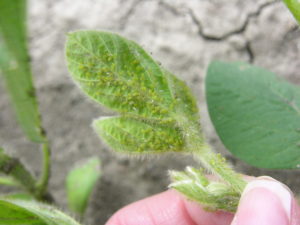I have been hearing reports of soybean aphids starting to pop up on non-Cruiser soybeans in Ontario. It has been a few years since we’ve had to deal with them so I thought a refresher might be in order.

Soybean aphids initially start to colonize in pockets of early planted fields. Several plants in these pockets can have hundreds, even thousands of aphids on them at first. Walk a few meters away from these pockets and you won’t find any aphids. Once the aphids start to get crowded on the plants in these pockets, they produce aphids with wings so they can spread out some more, colonizing new plants in the field. Populations then change from several hundred per plant in small pockets in the field, to only a few per plant on more plants across the field. This continues to occur, particularly when the plants are still in their V stages. Insecticide trials have not been able to show any yield response to sprays done on these V stage infestations. In fact, a spray application during the V stages can actually cause problems as it easily wipes out the natural enemies that are trying to do the work for you.
During the R1 to R5 stage of soybeans, an insecticide application is required once 80% of the plants in the field have at least 250 aphids per plant and it is apparent that the population is on the increase. Experience has shown that natural enemies can keep the aphid population fluctuating above and below the threshold. This fluctuation means they are working hard for you, trying to take down the aphid population. Only when you see the aphid population continue to rise instead of fluctuate, do you know that the natural enemies are not plentiful enough to keep up.

To help take all of this guess work out of all of this, we (University of Guelph & OMAF and MRA) have developed the free “Aphid Advisor” smartphone app” available for both Blackberries and IPhones available at: http://www.aphidapp.com/ When your soybean plants are in the R1 to R5 stages, just input the average number of aphids per plant from at least 10 random plants i the field. Then input the number of natural enemies you are seeing. The Aphid Advisor will tell you (based on proven field trial work done in Ontario) if you need to spray, wait a few days and re-scout, or don’t spray..based on thetype and ratio of natural enemies to soybeans aphids that are present in the field. And if you “Submit the Data” once you are done, your results will be graphed with others in each county so everyone can see which counties have needed to spray or didn’t have to.
If you do need to spray, refer to Publication 812 for recommended products. I do not recommend the use of a neonicotinoid foliar insecticide (active: imidacloprid or thiamethoxam) on soybeans, particularly when there are flowers on the plants, as recent studies indicate that bees and other pollinators frequently visit soybean plants during flowering.
